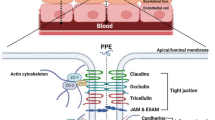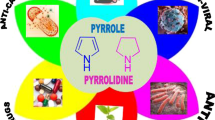Abstract
Purpose.
A peptide inhibitor of myosin light chain kinase (MLCK), termed membrane permeant inhibitor of myosin light chain kinase (PIK), has previously been demonstrated to correct paracellular barrier defects associated with in vitro cell models of infectious and inflammatory intestinal disease. The current study describes a strategy to identify stable analogues of PIK required for future in vivo studies that has resulted in the identification of two promising candidates.
Methods.
Because PIK functions at an intracellular site of epithelial cells and is envisaged to be administered orally, hydrolysis patterns were determined for PIK in both extracts of homogenized Caco-2 (a human intestinal epithelial cell line) and in luminal secretions isolated from rat intestine. Based on these hydrolysis patterns, four peptides Ac-RKKYKYRRK-NH2 (acetylated PIK), rkkykyrrk-NH2 (D PIK), krrykykkr-NH2 (Dreverse PIK), and RKKykyRRK-NH2 (Dpalindrome PIK) were synthesised. Studies were carried out to determine the stability, activity, and selectivity of these PIK analogues.
Results.
D PIK and Dreverse PIK had much longer half-lives of 3.6 and 13.4 h, respectively, compared to PIK, acetylated (Ac)-PIK, or Dpalindrome PIK. All PIK analogues inhibited MLCK potently, although D PIK was a slightly better inhibitor than the other analogues. Similarly, all PIK analogues enhanced paracellular barrier function in Caco-2 monolayers studied in vitro. No appreciable inhibition of cAMP-dependent protein kinase (PKA) or calcium/calmodulin-dependent protein kinase II (CaMPKII) was detected with any of the analogues.
Conclusions.
PIK is quickly degraded within two enzyme-containing preparations that represent different aspects of the intestinal environment. The PIK analogues D PIK and Dreverse PIK demonstrated extended half-lives in these enzyme preparations while retaining the biological activity and specificity of the parent PIK peptide.
Similar content being viewed by others
Abbreviations
- CD:
-
Crohn disease
- GVHD:
-
graft-versus-host disease
- IBD:
-
inflammatory bowel disease
- MLCK:
-
myosin light chain kinase
- PIK:
-
membrane permeant inhibitor of myosin light chain kinase
- TER:
-
transepithelial electrical resistance
- UC:
-
ulcerative colitis
References
1. D. R. Clayburgh, L. Shen, and J. R. Turner. A porous defence: the leaky epithelial barrier in intestinal disease. Lab. Invest. 84:282–291 (2004).
2. G. Bouma and W. Strober. The immunological and genetic basis of inflammatory bowel disease. Nat. Rev. Immunol. 3:521–522 (2003).
3. E. Carty and D. S. Rampton. Evaluation of new therapeutics for inflammatory bowel disease. Br. J. Clin. Pharmacol. 56:351–361 (2003).
4. G. R. May, L. R. Sutherland, and J. B. Meddings. Is small intestinal permeability really increased in relatives of patients with Crohn’s disease? Gastroenterology 104:1627–1632 (1993).
5. J. R. Turner. ‘Putting the squeeze‘ on tight junctions: understanding cytoskeletal regulation. Semin. Cell. Dev. Biol. 11:301–308 (2000).
6. J. R. Turner, B. K. Rill, S. L. Carlson, D. Carnes, R. Kerner, R. J. Mrsny, and J. L. Madara. Physiological regulation of epithelial tight junctions is associated with myosin light-chain phosphorylation. Am. J. Physiol. 273:C1378–C1385 (1997).
7. Y. Zolotarevsky, G. Hecht, A. Koutsouris, D. E. Gonzalez, C. Quan, J. Tom, R. Mrsny, and J. R. Turner. A membrane-permeant peptide that inhibits MLC kinase restores barrier function in in vitro models of intestinal disease. Gastroenterology 123:163–172 (2002).
8. P. G. Heyworth, R. W. Erickson, J. Ding, J. T. Curnutte, and J. A. Badway. Napthalenesulphoamides block neutrophil superoxide production by intact cells and in cell-free system: is myosin light chain kinase responsible for these effects? Biochem. J. 311:81–87 (1995).
9. T. J. Lukas, S. Mirzoevea, U. Slomezynska, and D. M. Watterson. Identification of novel classes of protein kinase inhibitors using combinatorial peptide chemistry based on functional genomics knowledge. J. Med. Chem. 42:910–919 (1999).
10. T. R. Soderling and J. T. Stull. Structure and regulation of calcium/calmodulin-dependent protein kinases. Chem. Rev. 101:2341–2351 (2001).
11. M. Ikebe, M. Stepinska, B. E. Kemp, A. R. Means and D. J. Hartshorne. Proteolysis of smooth muscle myosin light chain kinase. Formation of inactive and calmodulin-independent fragments. J. Biol. Chem. 262:13828–13843 (1987).
12. J. J. Berglund, M. Riegler, Y. Zolotarevsky, E. Wenzl, and J. R. Turner. Regulation of human jejunal transmucosal resistance and MLC phosphorylation by Na+-glucose cotransport. Am. J. Physiol.—Gastrointest. Liver Physiol. 281:G1487–1493 (2001).
13. R. B. Pearson, J. R. Woodgett, P. Cohen, and B. R. Kemp. Substrate specificity of a multifunctional calmodulin-dependent protein kinase. J. Biol. Chem. 260:14471–14476 (1985).
14. J. R. Turner, J. M. Angle, E. D. Black, J. L. Joyal, D. B. Sacks, and J. L. Madara. Protein kinase C-dependent regulation of transepithelial resistance: the roles of myosin light chain and myosin light chain kinase. Am. J. Physiol. 277:C554–C562 (1999).
15. M. Chorev and M. Goodman. Recent developments in retro peptides and proteins – an ongoing topochemical exploration. Trends Biotechnol. 13:438–445 (1995).
Author information
Authors and Affiliations
Corresponding author
Additional information
Note: This revised article was published online in June 2005. Both authors Owens and Graham contributed equally.
Rights and permissions
About this article
Cite this article
Owens, SE., Graham, W., Siccardi, D. et al. A Strategy to Identify Stable Membrane-Permeant Peptide Inhibitors of Myosin Light Chain Kinase. Pharm Res 22, 703–709 (2005). https://doi.org/10.1007/s11095-005-2584-9
Received:
Accepted:
Published:
Issue Date:
DOI: https://doi.org/10.1007/s11095-005-2584-9




